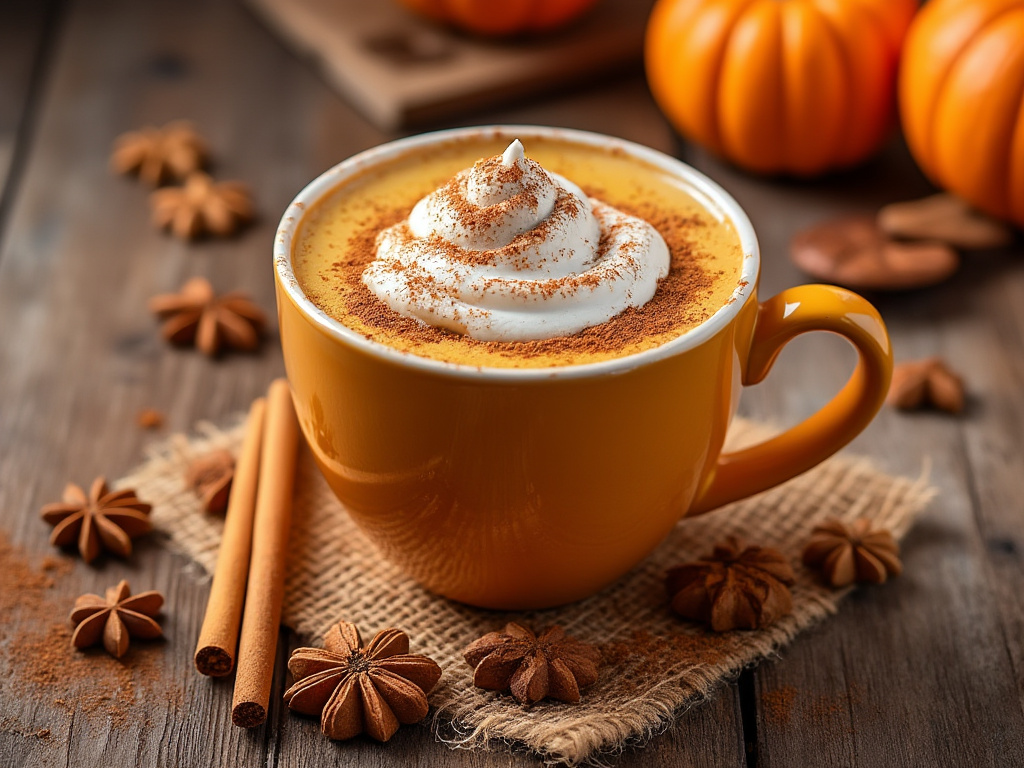
How Pumpkin Spice Became Fall’s Favorite Drink
Published on November 7, 2024
Unlike another food associated with fall, apples, pumpkins are native to the Americas, with archaeologists dating seeds found in a cave in Oaxaca, Mexico back to somewhere between 8,000 and 10,000 years ago. The seeds were of an orange squash called Curcubita pepo, which was a derivation of the Greek word for melon, “pepon,” and eventually became anglicized to “pumpkin.”
By Dave Lifton (@daveeatschicago)
The spice part of the equation, though, has its origins in America’s colonial history. Located east of Indonesia, the Banda Islands became an important target for European traders due to the abundant natural resources that earned the archipelago the nickname of the “Spice Islands.” The island of Rhun was particularly valuable because it was the world’s only source of nutmeg, which was used as both an ingredient and a medicine. Cinnamon (Sri Lanka), ginger (Maritime Southeast Asia), and cloves (Maluku and other islands) were grown nearby.
The Portuguese arrived first, in the early 16th century, although their attempts at establishing a permanent settlement were unsuccessful. The Dutch and the English, both of whom arrived in the early 1600s, fared better, but soon found themselves fighting for control. The hostilities ended in 1667 with the Treaty of Breda, where the Dutch ceded their claim to their colony of New Amsterdam in exchange for Rhun, the only Spice Island controlled by England.
To put it another way, the Dutch traded New York for nutmeg.
In 1796, Amelia Simmons published American Cookery, the first cookbook written by an American. In it, she offered two recipes for a “pompkin” pudding that were baked in a pie crust. The first was spiced with nutmeg, mace (made from the nutmeg seed’s covering), and ginger, and the second involved molasses, allspice, and ginger.
More recipes emerged in the 19th century, all of which required some blend of the sweet, exotic spices from the Banda Islands, which by now had become available in America. During that time, the pumpkin became associated with Halloween due to the tradition of the jack-o’-lantern coming from Ireland.
New technologies in the 1800s also led to further growth of pumpkin pie. The first was canning, meaning that home bakers didn’t have to go through the lengthy process of cooking the pumpkin to soften it, then straining or mashing it into a puree. Plus, it could be sold year-round. The second was the emergence of spice companies that mechanized the process of grinding them.
In 1933, Chicago-based Thomson & Taylor unveiled a blend of nine spices that were “perfect in flavor, color and aroma” for making pumpkin pie. Shortly thereafter, McCormick introduced a mixture ideal for pumpkin pie and gingerbread.
Fast-forward to early 2003, when Starbucks, which had recent successes with seasonal beverages like the peppermint mocha and gingerbread latte, was developing another drink for the fall season. Director of espresso Peter Dukes tasked his team to come up with autumnal flavors that paired well with coffee. Market research showed that chocolate and caramel would be the most successful, but the idea of pumpkin spice intrigued the respondents.
Dukes’ group proceeded to alternate bites of pumpkin pie with sips of espresso to figure out which spices worked best, and then spent three months perfecting the recipe. Starbucks tried out the pumpkin spice latte in approximately 100 stores in Washington, D.C. and Vancouver that fall, and the response was overwhelmingly positive.
“Within the first week of the market test, we knew we had a winner,” he said. “I remember calling store managers on the phone to see how the new beverage was doing, and we could hear the excitement in their voices.”
The drink was launched across North America the next year, and it took off from there. Starbucks credits the growth to the contemporaneous emergence of social media, with countless customers declaring their love of the “PSL,” as it became known, in posts on Facebook and Twitter.
Starbucks continues to unveil new autumnal concepts annually, but the PSL remains the champion, and it’s been estimated that more than 600 million have been sold as of 2024. But there has been a chance to the recipe. In 2015, Starbucks replaced the caramel color with a little bit of pumpkin puree.
The success of the PSL has created a chain reaction in the food and beverage industry, with everything from mass-produced breakfast cereals to craft cocktails at local bars and restaurants being available in a mixture of cinnamon, ginger, nutmeg, and other spices for the fall. Of course, that has also led to a backlash from those who don’t like the flavor and/or see it as embodiment of their feelings about capitalism. However, the fact that new products are introduced every year suggests that it does not seem to be having any tangible effect.
The author of this article proudly admits to being a sucker for nearly every limited-edition pumpkin spice product he sees every fall.

The Adventure starts when you say it does.
All eATLAS Adventures are designed and built by experienced eATLAS Whoa!Guides. They're always on. Always entertaining. And always ready to go.
Check out our Adventures!